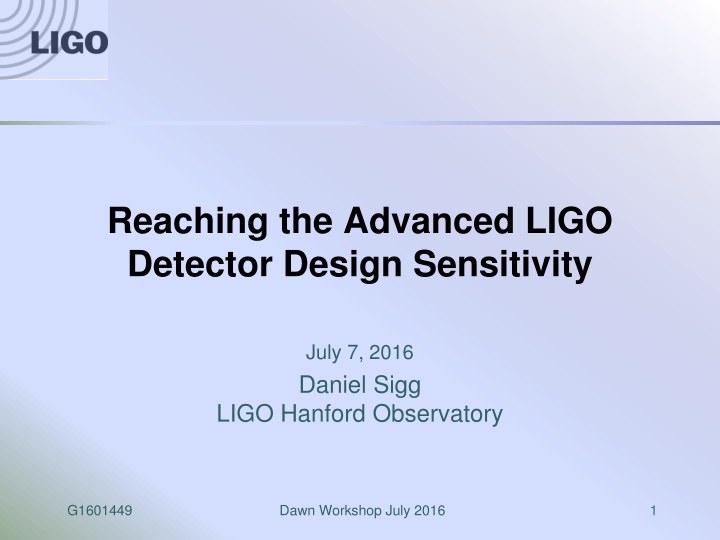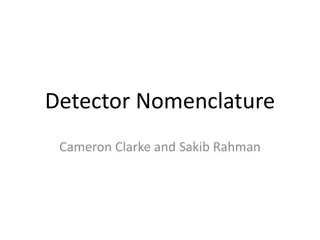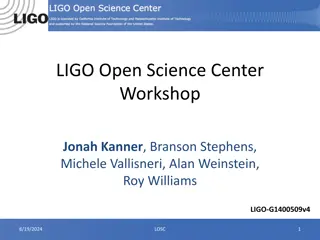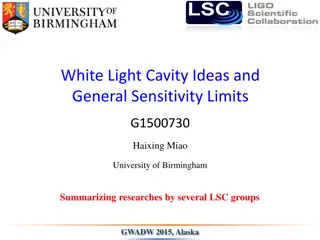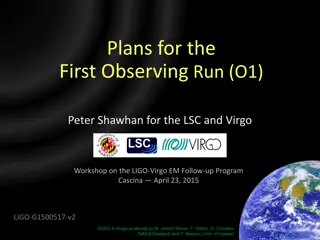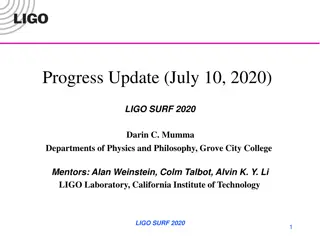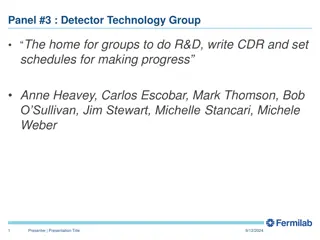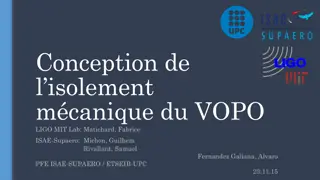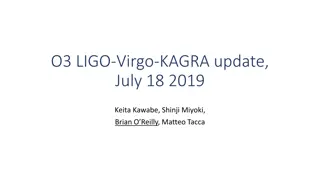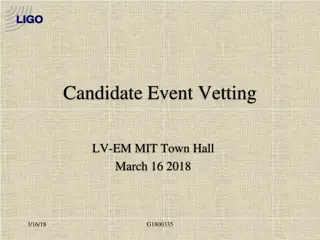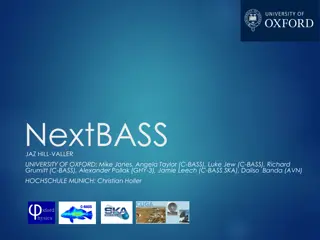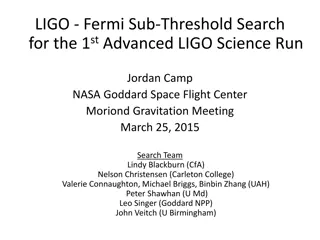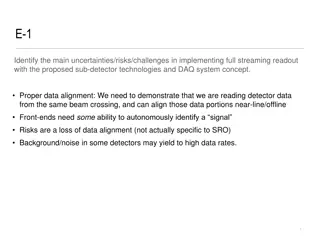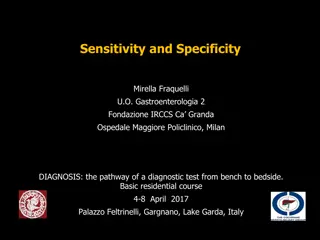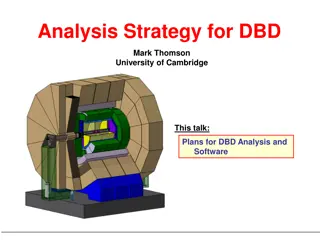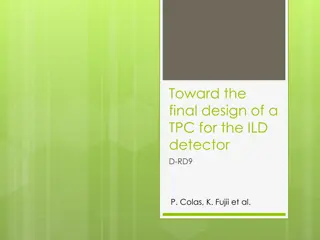Challenges and Plans for Reaching Advanced LIGO Detector Sensitivity
The presentation outlines the challenges and strategies for enhancing the sensitivity of the Advanced LIGO detector. It discusses the plan to interleave commissioning with observation runs, set sensitivity goals for early runs, and address major challenges like low-frequency noise and increasing laser power. The timeline details the in-chamber work and adjustments required for boosting sensitivity. Post-O1 commissioning suggestions and improvements are also highlighted.
Download Presentation

Please find below an Image/Link to download the presentation.
The content on the website is provided AS IS for your information and personal use only. It may not be sold, licensed, or shared on other websites without obtaining consent from the author.If you encounter any issues during the download, it is possible that the publisher has removed the file from their server.
You are allowed to download the files provided on this website for personal or commercial use, subject to the condition that they are used lawfully. All files are the property of their respective owners.
The content on the website is provided AS IS for your information and personal use only. It may not be sold, licensed, or shared on other websites without obtaining consent from the author.
E N D
Presentation Transcript
Reaching the Advanced LIGO Detector Design Sensitivity July 7, 2016 Daniel Sigg LIGO Hanford Observatory G1601449 Dawn Workshop July 2016 1
Plan Interleave commissioning with observation runs Shorter runs at the beginning Work in stages O1: ~3 months, we could get lucky O2: ~6 months run at ~100 Mpc O3: long run at ~150 Mpc Commissioning: After O1: Increase power to 50W+ After O2: Increase power to 100W+ (or squeezing) G1601449 Dawn Workshop July 2016 2
Sensitivity Goals for Early Runs O1 O2 projection with 50 W laser power G1601449 Dawn Workshop July 2016 3
Major Challenges Understand and suppress low frequency noise Alignment noise Auxiliary degrees-of-freedom Unknown noise sources and unknown coupling mechanism Increase power from ~25W (O1) to ~150W Thermal lensing and thermal compensation Control alignment instabilities w/o degrading noise Control parametric instabilities G1601449 Dawn Workshop July 2016 4
In Detail: Post O1 Commissioning Double the laser power: 25 W 50 W Requires activating High Power Oscillator stage Currently at 40W at LHO LLO: Plagued by laser problems Diagnose and reduce low-frequency noise Diagnose and reduce other instrumental artifacts transient noises and spectral lines observed in O1 Improve uptime Work on robustness & stability G1601449 Dawn Workshop July 2016 5
Timeline between O1 & O2 in-chamber work laser power work noise investigations 2016 JAN FEB MAR APR MAY JUNE JULY AUG SEP Low frequency noise work High power preparations: ASC, TCS, PI damping HPO Power increase to 50 W H1 HAM6 output detection chamber ER10/O2 Full early start: interferometer beg-Aug Low frequency noise work Corner vent: Sensitivity improvements Faraday, CPY, BRDs, baffles, etc. Power increase to 50 W HPO rebuild L1 high power oscillator 25 W EX/EY vents: BRD, RH HAM6 bounce & roll damper, ring heater output detection chamber G1601449 Dawn Workshop July 2016 6
L1: In-vacuum work for O2 Sensitivity Faraday isolator, high QE photodetectors Passive dampers for HAM seismic isolator components Stray light baffles Laser Power Increase Thermal compensation in signal recycling cavity Robustness Passive tuned dampers for test mass suspension modes G1601449 Dawn Workshop July 2016 7
Low Frequency Noise Mystery noise(s) G1601449 Dawn Workshop July 2016 8
Updated Noise Budget G1601449 Dawn Workshop July 2016 9
In Detail: Post O2 Commissioning Replace end test masses and end reaction masses Fix 532nm coating error should help with robust locking Fix phase ripple that scatters light Reduce squeezed film damping with new annular ERM Replace Compensation Plate on H1 (a la L1) Test mass Suspension mode dampers for H1 Dampers for triple suspensions in development Uptime Robustness Improve wind mitigation at LHO (tilt sensors, wind fences) Acoustic mode dampers for test masses 3rd technique for Parametric Instability mitigation; still in development G1601449 Dawn Workshop July 2016 10
Squeezed Light Injection: Post O2/O3 LIGO-T1400366-v2 HAM6 from OPO photodiode: feed-back to PUMP laser frequency PUMP LASER Squeezed light source with in-vac OPO currently in development Provide 3-5 dB of quantum noise reduction at high frequencies & corresponding increase in radiation pressure noise Planning to make this an option for post-O2 Addition of filter cavity would limit the low-frequency noise increase Short filter cavity: do no harm In development for testing at MIT-LASTI Planning this as a post-O3 option Squeezed Source Light CONTROL OPO green pump beam LASER frequency shifted SHG control beam HAM5 Output Faraday Isolator Interferometer LASER SRM SR3 Interferometer Output Beam Filter Cavity 16 m HAM4 SR2 TCS beam path G1601449 Dawn Workshop July 2016 11 Figure 5: Integration of a squeezer in Advanced LIGO. This drawing shows the HAM5 and HAM6 chambers populated with the current Advanced LIGO equipment, plus addi- tional components for frequency dependent squeezing. page 12 of 15
Summary Sensitivity of initial detectors was surpassed quickly Successful O1 run and first GW detection There is now more incentive to run Explanation for low frequency noise is elusive High power operations hampered by laser problems Improvements in seismic High wind & high seis problem at LHO: tilt meters were installed Major vent at LLO: fix Faraday, ITM comp, BS baffle, etc. Ready for O2 in September of this year G1601449 Dawn Workshop July 2016 12
Mystery Low Frequency Noise (1) What s known: Possible explanation at lower end, but not at 80 Hz Similar level between H1 and L1 L1 shows additional bumps (maybe due to scattering) Relatively stationary To reach above 100Mpc NS inspiral range we need both Reduce this noise and Higher laser power to reduce shot noise Unknown: What causes it Single or multiple sources Exact spectral shape (not enough exposed, but not flat) G1601449 Dawn Workshop July 2016 13
Mystery Low Frequency Noise (2) It ain t: ETM/ITM coating thermal or SUS thermal Just scattering (too stationary) Suspension drive electronics Electric charge Sensing noise Laser noise (frequency, intensity, RFAM) Beam jitter Angular control noise Up-conversion Beamsplitter motion OMC related PEM related such as acoustic, seismic, magnetic, G1601449 Dawn Workshop July 2016 14
Mystery Low Frequency Noise (3) Still out there: Scattering (not completely ruled out) Squeezed film damping Mechanical interference Anything in the SRC such as ITM/BS AR coatings G1601449 Dawn Workshop July 2016 15
